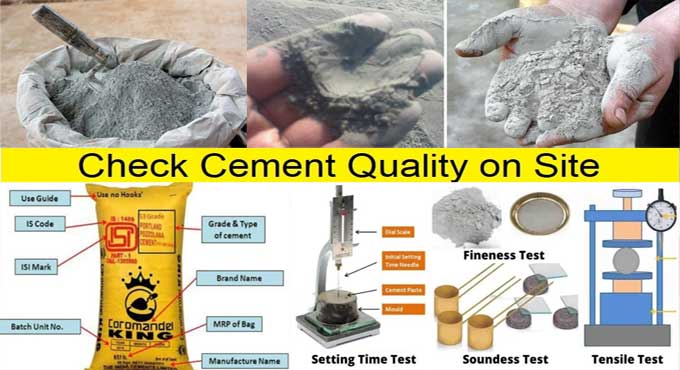NEWS | SOFTWARE | SHEET
How to Check Quality of Cement at Site
Low-quality cement is detrimental to the life of a structure or home because it reduces the strength of concrete, which dramatically reduces its service life. Ultimately, the construction of homes with inferior cement led to financial losses for homeowners and sometimes resulted in their safety being at risk.
There are several things you can do to ensure the quality of cement on the construction site which will be discussed in this article.
A regular person can easily carry out this test, and from that, they can determine whether the cement is high-quality or not by looking at the results.
The manufacturing date of the concrete
A cement bag should have the date of manufacture displayed on it and it is necessary because the strength of cement deteriorates with the passage of time.
As a powder, cement is a very fine substance that absorbs moisture very quickly from the atmosphere. There is always a small amount of moisture in the air, which is absorbed by the cement bag as the moisture is absorbed by the cement bag.
The cement gradually loses its strength as the moisture absorbed by the bag is absorbed by the cement bag.
Approximately half of the strength of cement that is produced after six months of production is lost when the cement is used. Whenever possible, it is recommended that cement bags be used within 3 months from the date on which cement is manufactured.
Essential cement checking method
Floating test method: Due to the additional dust that is added to the cement, the strength of the cement is reduced. If you are checking for dust in a bucket of water, take a small amount of cement and place it in the bucket.
High-quality the presence of impurities in the cement, which shows its poor quality, is shown by the cement’s immediate sinking. The cement of this kind will have a detrimental effect on the strength of concrete.
Coloring test method: Cement's color indicates how much lime or clay has been incorporated into the mixture as well as how much of the material has been burned. Before using cement on a construction site, make sure that you check the cement's color because it can often have a dark greenish-grey hue to it.
It is possible that the cement is a rather old variety or that moisture is attacking it due to its light gray color.
Temperature testing method: Cement in a bag tends to remain cold for most of the time, so when you touch it, you may feel it as being cold, so if you wish to check the temperature of the cement in a bag, place your hand inside it first to feel how it feels.
Generally speaking, if the product is cold inside, then it is of good quality, whereas if it is warm inside, then it clearly indicates that there is a loss of hydration occurring, which means it is of inferior quality.
Smell testing method: By smelling the cement, one can detect whether it is adulterated with clay or silt, and if the cement is adulterated with too much clay and silt, the paste will have an earthy smell to it.
To get more details, watch the following video tutorial.
Lecturer: F&U-FORYOU
Shaping testing method: Make a stiff paste by adding some water to 100 grams of cement and mixing it well to prepare a fine paste. Put the bucket of cement paste on a glass plate, and then place the cake on a glass plate with sharp edges and slowly submerge it in the bucket of cement paste.
When being transported to the bottom of the bucket, the shape of the cake should not be disturbed. During the setting and strengthening process, the cake must retain its original shape.
Adulterine testing method: There is a process known as adulteration, which refers to the act of adding other substances to something in order to lower its quality. If you rub a piece of cement between your fingertips, you will feel that it is extremely smooth because cement is made of an extremely fine substance.
A cement of such quality is considered to be high-quality cement. However, if you are experiencing grit or roughness that indicates that the cement contains other materials, such as silt or sand, which could affect the strength of the cement.


